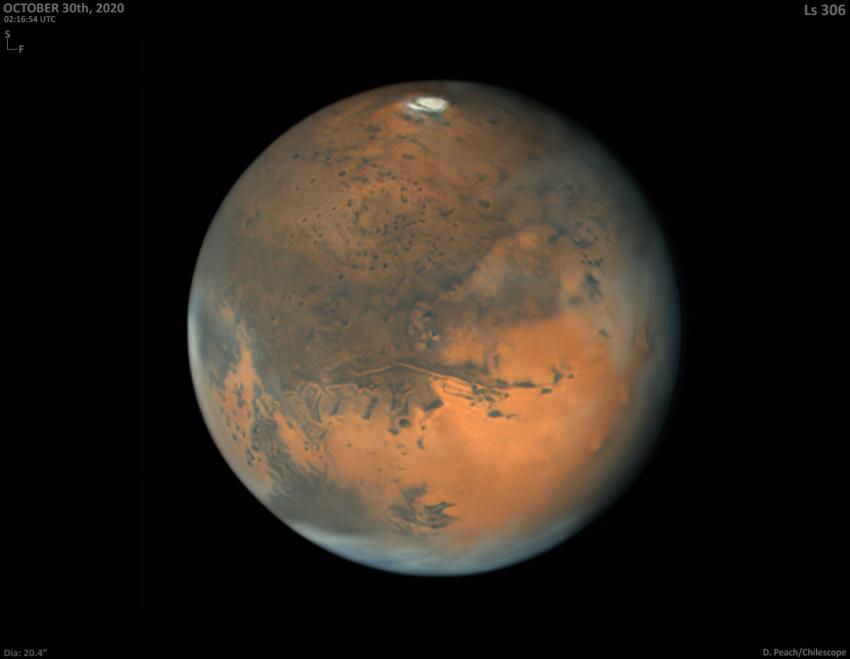The eighth National Astronomy Week (NAW 2020) will run from 14 to 22 November. Throughout NAW, UK astronomers will celebrate the close approach of Mars to the Earth with a series of free online talks and remote observing events. The Royal Astronomical Society is supporting NAW 2020 as part of its bicentenary celebration, and in conjunction with other UK astronomical and scientific organisations.
NAW takes place every few years in connection with a particular astronomical event, beginning in 1981 with the 200th anniversary of the discovery of Uranus. NAW 2020 focuses on Mars, which is currently close to the Earth and visible as a bright red object high in the evening sky. Several space missions are also en route to the red planet, and the possibility of past and present life there is of huge interest to scientists and the public alike.
Previous NAWs featured public observing sessions, with over 200 being organised all around the country in 2014 to observe Jupiter. But this year the Covid-19 pandemic means no face-to-face public events can safely take place, so NAW 2020 will be entirely online.
Science centres around the country are running morning sessions aimed at schoolchildren in particular, although anyone at home is also welcome to view them. There will also be evening shows hosted by leading astronomers and presenters such as Professor Chris Lintott, Professor Jane Greaves and Dallas Campbell.
Then instead of public observing, every evening there will be live-streamed views of the planet seen through amateur and professional telescopes at home and abroad, backed up with simultaneous question-and-answer forums.
The NAW 2020 website has a wealth of information about the red planet, aimed at the general public. There are articles on where to look for Mars, tips on observing the planet using those small telescopes which may be languishing in their boxes under the bed, and even on the planet’s many myths and mysteries, such as what happened to the canals!
NAW 2020 Chair Lucinda Offer said “National Astronomy Week is a fantastic chance to see and find out more about Mars, a world that has fascinated people for hundreds of years. We hope that with our imaginative online approach, this year’s National Astronomy Week will reach more people around the country than ever before.”
Mars is easily visible looking south in the evening, as a bright reddish object high in the sky. Also visible are Jupiter and Saturn, fairly low in the west after sunset. The crescent Moon will be in the western sky after sunset from 16 November onwards, and 17 November sees the peak of the Leonids meteor shower.
Media contacts
Lucinda Offer
Royal Astronomical Society (NAW Chair)
loffer@ras.ac.uk
Robin Scagell
Society for Popular Astronomy
robin@popastro.com
Peta Bosley
British Astronomical Association
petabosley@ntlworld.com
Dr Paul Daniels
President, Federation of Astronomical Societies
president@fedastro.org.uk
Image and caption
Note that this image is only available for use in relation to this story. Please contact Damian Peach for permission to use it for any other purpose.
Notes for editors
About NAW 2020
The NAW 2020 committee comprises representatives from all the major UK astronomical societies and organisations, including the Royal Astronomical Society, the British Astronomical Association, the Society for Popular Astronomy and the Federation of Astronomical Societies. The committee also includes the Science and Technology Facilities Council, the British Association of Planetaria, Association of Science and Discovery Centres, the Observatory Science Centre and the South Downs Planetarium and Science Centre.
Follow NAW 2020 on Twitter, Facebook, Instagram and YouTube
About the Royal Astronomical Society
The Royal Astronomical Society (RAS), founded in 1820, encourages and promotes the study of astronomy, solar-system science, geophysics and closely related branches of science. The RAS organises scientific meetings, publishes international research and review journals, recognises outstanding achievements by the award of medals and prizes, maintains an extensive library, supports education through grants and outreach activities and represents UK astronomy nationally and internationally. Its more than 4,400 members (Fellows), a third based overseas, include scientific researchers in universities, observatories and laboratories as well as historians of astronomy and others.
In 2020 the RAS is 200 years old. The Society is celebrating its bicentennial anniversary with a series of events around the UK, including public lectures, exhibitions, an organ recital, a pop-up planetarium, and the culmination of the RAS 200: Sky & Earth project.
Follow the RAS on Twitter, Facebook, Instagram and YouTube, and subscribe to the RAS Supermassive podcast


